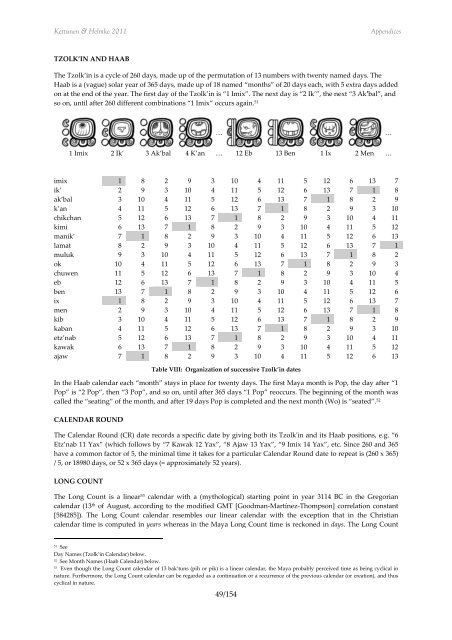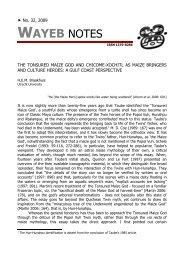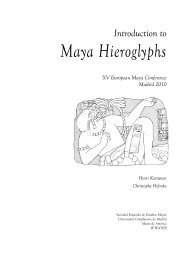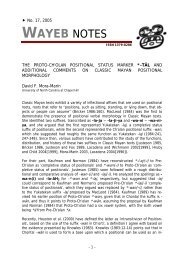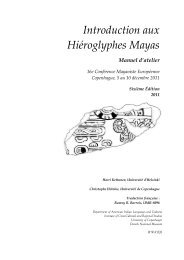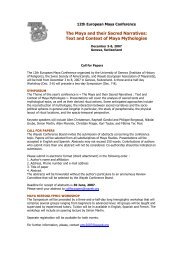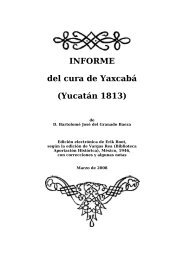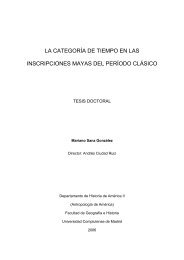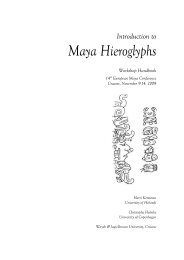Introduction to Maya Hieroglyphs - Wayeb
Introduction to Maya Hieroglyphs - Wayeb
Introduction to Maya Hieroglyphs - Wayeb
Create successful ePaper yourself
Turn your PDF publications into a flip-book with our unique Google optimized e-Paper software.
Kettunen & Helmke 2011<br />
Appendices<br />
TZOLK’IN AND HAAB<br />
The Tzolk’in is a cycle of 260 days, made up of the<br />
permutation of 13 numbers with twenty<br />
named days.<br />
The<br />
Haab is a (vague) solar<br />
year of 365 days, made up of 18 named “months” of 20 days each, with 5 extra days added<br />
on at the end of the year. The first day of the Tzolk’in is “1 Imix”. The next day is “2 Ik’”, the next “3 Ak’ ’bal”, and<br />
so on, until after 260 different combinations “1 Imix” occurs again. 51<br />
…<br />
…<br />
1 Imix<br />
2 Ik’<br />
3 Ak’bal<br />
4 K’an<br />
… 12 Eb<br />
13 Ben<br />
1 Ix<br />
2 Men<br />
…<br />
imix<br />
ik’<br />
ak’bal<br />
k’an<br />
chikchan<br />
kimi<br />
manik’<br />
lamat<br />
muluk<br />
ok<br />
chuwen<br />
eb<br />
ben<br />
ix<br />
men<br />
kib<br />
kaban<br />
etz’nab<br />
kawak<br />
ajaw<br />
1<br />
2<br />
3<br />
4<br />
5<br />
6<br />
7<br />
8<br />
9<br />
10<br />
11<br />
12<br />
13<br />
1<br />
2<br />
3<br />
4<br />
5<br />
6<br />
7<br />
8<br />
9<br />
10<br />
11<br />
12<br />
13<br />
1<br />
2<br />
3<br />
2<br />
3<br />
4<br />
5<br />
6<br />
7<br />
8<br />
9 10<br />
9<br />
10<br />
11<br />
12<br />
13<br />
1<br />
2<br />
3<br />
4<br />
4 11 5<br />
5 12 6<br />
6 13 7<br />
7<br />
8<br />
9<br />
10<br />
11<br />
12<br />
13<br />
1<br />
1 8<br />
2 9<br />
3 10<br />
4 11<br />
5 12<br />
6 13<br />
7 1<br />
8 2<br />
3 10<br />
4 11<br />
5 12<br />
6 13<br />
7 1<br />
8 2<br />
9 3<br />
10 4<br />
11 5<br />
12 6<br />
13 7<br />
1 8<br />
2 9<br />
3 10<br />
4 11<br />
5 12<br />
6 13<br />
7 1<br />
8 2<br />
9 3<br />
4 11<br />
5 12<br />
6 13<br />
7 1<br />
8 2<br />
9 3<br />
10 4<br />
11 5<br />
12 6<br />
13 7<br />
1 8<br />
2 9<br />
3 10<br />
4 11<br />
5 12<br />
6 13<br />
7 1<br />
8 2<br />
9 3<br />
10 4<br />
5 12 6<br />
6 13 7<br />
7<br />
8<br />
9<br />
10<br />
11<br />
12<br />
13<br />
1<br />
2<br />
3<br />
1<br />
2<br />
3<br />
4<br />
5<br />
6<br />
7<br />
8<br />
9<br />
10 8<br />
9<br />
10<br />
11<br />
12<br />
13<br />
1<br />
2<br />
3<br />
4<br />
4 11 5<br />
5 12 6<br />
6 13 7<br />
7<br />
8<br />
9<br />
10<br />
11<br />
1 8<br />
2 9<br />
3 10<br />
4 11<br />
5 12<br />
13 7<br />
1 8<br />
2 9<br />
3 10<br />
4 11<br />
5 12<br />
6 13<br />
7 1<br />
8 2<br />
9 3<br />
10 4<br />
11 5<br />
12 6<br />
13 7<br />
1 8<br />
2 9<br />
3 10<br />
4 11<br />
5 12<br />
6 13<br />
Table VIII: Organization of successive Tzolk’in dates<br />
In the Haab calendar each “month” stays in place<br />
for twenty days. The first <strong>Maya</strong> month is Pop, the day after “1<br />
Pop” is “ 2 Pop”, then “3 Pop”, and so on, until after 365 days “1 Pop” reoccurs. The beginning of the month was<br />
called the<br />
“seating” of the month, and after 19 days Pop is completed and the<br />
next month (Wo) is “seated”. 52<br />
CALENDAR ROUND<br />
The Calendar Round ( CR) date records a specificc date by giving both its Tzolk'in and its Haab positions, e.g. “6<br />
Etz’nab 11 Yax” (whichh follows by “7 Kawak 12 Yax”, “8 Ajaw<br />
13 Yax”, “9 Imix 14 Yax” ”, etc. Since 260 and 365<br />
have a common fac<strong>to</strong>r of 5, the minimal time it takes for a particular Calendar Round date<br />
<strong>to</strong> repeat is (260 x 365)<br />
/ 5, or 18980 days, or 52<br />
x 365 days (=<br />
approximately 52 years).<br />
LONG COUNT<br />
The Long<br />
Count is a linear 53 calendar with a (mythological)<br />
starting point in year 3114 BC in the Gregorian<br />
calendar (13 th of August, according <strong>to</strong> the modified GMT [Goodman-Martínez-Thompson] correlation<br />
constant<br />
[584285]). The Long Count calendar resembles our linear calendar with the exception<br />
that in the Christian<br />
calendar time is computed in years whereas in the <strong>Maya</strong> Long<br />
Count time is reckoned in<br />
days. The Long Count<br />
51<br />
See<br />
Day Names (Tzolk’in Calendar) below.<br />
52<br />
See Month Names (Haab Calendar) below.<br />
53<br />
Even though the Long Count calendar of 13 bak’tuns (pih or pik) is a linear calendar, the <strong>Maya</strong> probably perceived time as being cyclical in<br />
nature. Furthermore, the Long Count calendar<br />
can be regardedd as a continuationn or a recurrence of the previous calendar (or creation), and thus<br />
cyclical in nature.<br />
49/154


